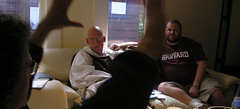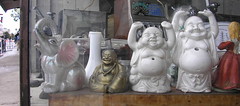How to Read Walks

“Any one may mimic the common French walk by twisting and tripping and ambling on tip-toe,” explained a journalist, “but real grace is not to be caricatured.” Indeed, from such a point of view, a person’s walk could be the surest evidence about their character.
Those who took this view advised gymnastic exercises designed to enhance the bodily systems as a whole. Alexander Walker and his wife offered a series of advice books for young ladies, outlining the proper exercises for perfecting the circulation between the “locomotive organs” of feet and legs to the “nutritive organs” of the trunk and “intellectual organs” of the head. From this point of view, the gait displayed more than mere professional or geographical origins to be overcome by dumbbells and stretches; posture and gait rather demonstrated how a subject had synthesized experience, whether into a false and affected demeanor, or into a graceful and holistic expression of psychological well-being.
From this point of view, observing strangers’ gaits was key to making sense of their psychological condition. Grant entered the halls of Parliament to describe the “steady pace, but…most ludicrous carriage” of Sir Francis Burdett, when he had received a public chastising by Maurice O’Connell. With his spirit sunk, he walked “as if he had been performing what soldiers call the dead march.” It was impossible for the politician to conceal his emotion, and the attempt to mask it manifest in stiff and uncomfortable posturing. Elsewhere, urban observers called upon posture to unmask the duplicity of entire ranks of people. James Grant, the journalist, laughed at the “would-be dignified step and consequential air” with which unemployed supporting actresses looking for work walked around Covent Garden, while Dickens characterized the “indescribable public-house-parlour swagger, and a conscious air,” of the actors. Thespians’ awkward posturing made visible and public the fact of their artificiality. “They always seem to think they are exhibiting,” Dickens chided. William Cobbett suggested that the exaggerated movements of soldiers stationed in Whitehall revealed truths their military training tried to hide: “those upstart beardless boys, with false whiskers, the bloody-livery servants of the public, that strut and swagger up and down St. James’s street all day with the long sword clinking at their heels upon the pavement, that their puny arms can scarce pull out of the scabbard.” They “wear on the heels” stiff leather boots that “hide their spindle shanks and false calves.” While military training disguised the boy as a man, the keen urban observer could see through the artifices of shoes and posture, reading the motions of walking as a key to character.
Theorists of physiognomy extrapolated such studies of walking into a science of character. Alexander Walker’s aesthetic philosophy of physiognomy drew most of its examples from the public display of bodies in public, especially those of women. Walker discussed gait as evidence of the relationship between internal and external beauty, explaining how “external indications as to mind may be derived from figure, from gait, and from dress.” Philosophy discerned the Kanting sublime in the perfections of strolling strangers. The critic would notice how the “vulgar woman” revealed by her gait “a character of mind and countenance,” belying the “inappropriate mask in which her milliner or dressmaker may have invested her.” Gait and posture therefore offered tools to revelation of universal truth freed from the particular circumstances of dress.
Reading public physiognomy depended on generalizing from the particularities of shoes, feet, and gait to the general truths of an individual’s character. Thomas Hood’s novel Tylney Hall played with reading strangers in a double sense. Assured the “taper waist” and “graceful easy carriage” as to a creole woman’s “good blood,” English squires in a novel trust her long enough to ask her to read their fortunes with regard to marriage. The creole woman discerns their fortunes accurately, the novelist suggests, by “narrowly watching the looks” on their faces. “These fortunetellers are excellent physiognomists,” explained the protagonist. It was appropriate, as well as ironic, that the squires should allow themselves to be read by a creole whom they themselves had just read on the street, for Englishmen everywhere were experimenting in the science of reading fortunes by watching physiognomies.










2 Comments:
Great blog! Keep up the good work.
Hi Jo,
I'm a friend of Graeme Wood's. I showed him a pitch for an article I was working on, and he seemed to think you'd be interested. It's about the geometry of Capability Brown's parks. He gave me your e-mail address and I lost it. Then today we found each other on Twitter, and I saw you among his followees. You wanna send me your e-mail?
Mine's chrisvnicholson at gmail etc.
Best,
Chris
Post a Comment
<< Home